Dr. Mae-Wan Ho presents highlights of her new book 'Living Rainbow H2O', World Scientific and Imperial College Press, 2012 [1]
Living H2O is the water that constitutes ~70 % of cells and organisms, and without which life is impossible. Living H2O covers the surfaces of macromolecules and membranes in cells, and interweaves with molecular fibrils of collagen and other extracellular proteins, providing intercommunication channels throughout the body so each molecule can keep in touch with every other in the ‘quantum jazz’ of life. It shapes and softens macromolecules, so they can function as coherent quantum molecular machines that transform energy at close to 100 % efficiency. Living H2O turns the whole organism liquid crystalline because it is liquid crystalline and quantum coherent. That’s why all organisms have a dancing rainbow inside (as described in ([2] The Rainbow and the Worm, The Physics of Organisms, ISIS publication, of which Living Rainbow H2O is a sequel.) Last and definitely not least, water provides the electrons and protons to fuel the photosynthesis-respiration dynamo that spins inanimate molecules into living organisms out of pure sunlight. Water is truly the medium, message and means of life.
Life itself originated in water-air and water-ice interfaces on oceans and lakes that are especially proficient at synthesizing organic molecules. Sunlight, wind, and waves, rain, lightning discharges, and volcanic eruptions, all conspire in providing energy for the organic synthesis and to create aerosols from the organic microlayers that are re-deposited to enrich the molecular diversity and complexity of interfaces until proto-life finally burst onto the scene.
Sterile in vitro systems of bulk water or bulk water on macroscopic interfaces are remarkable enough; and very important for understanding living H2O; but they cannot compare with the incredibly dynamic situation inside the living cell. Water in bulk is also demonstrably different from water confined in a variety of non-living nanospaces that are more representative of the intracellular and extracellular milieu in life. Indeed living water is predominantly water confined to nanospace.
Intracellular water occupies percolating fractal nanospaces approximated by a mathematical Sierpinski’s sponge. (A fractal is a structure with fractional dimensions that exhibit self-similarity over different scales.) Similarly, the fractal structure of collagen fibres and sheets in the extracellular matrix ensures that extracellular water is also in fractal nanospaces. Together, intracellular and extracellular water permeates and interconnects the entire organism. That is why living H2O is perfect for intercommunication over all space-time scales, both locally and globally. Indeed, recent findings indicate that water confined in nanospace is both quantum coherent and superconducting [3] (Superconducting Quantum Coherent Water in Nanospace, SiS 55). It is time to take the new cell biology based on water seriously.
Let me present some highlights in living water’s continuing biopic.
The most important feature of water is the hydrogen bond that connects water molecules into an extended network involving more than 95 % of the molecules at room temperature at any instant, though the bonds are extremely dynamic, making and breaking in a matter of picoseconds (10-12s).
The hydrogen bond appears to separate liquid water into two states: one with the bond angles and lengths in tetrahedral configuration as in ordinary ice (Figure 1) and the other with much less order, corresponding to low density water and high density water respectively.
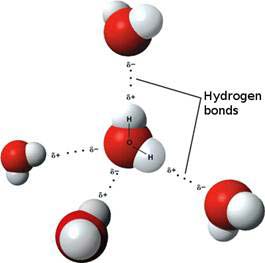
Figure 1 Water molecules hydrogen-bonded in tetrahedral ice-like fashion
The usual explanation for the tetrahedral ice-like hydrogen bonding is that it is the thermodynamically favoured state according to electrostatic interactions between positively and negative charged parts of the molecules. But that is not correct.
It turns out that the ice-like tetrahedral configuration is a consequence of quantum mechanical interactions in liquid water. More specifically, it is a consequence of quantum coherent domains forming in bulk liquid water even at room temperature and pressure, predicted by a quantum electrodynamics field theory due to Giuliano Preparata, Emilio del’Guidice and colleagues at University of Milan in Italy. The interaction between liquid water and the ambient electromagnetic field excites water molecules to form stable coherent domains that oscillate in phase with the electromagnetic field. Liquid water is thus a mixture of coherent domains about 100 nm in diameter interspersed with incoherent domains in the proportion of ~4:6 at room temperature. The tetrahedral 4-coordinated structure is associated with the coherent domains, while more disordered, non-tetrahedral hydrogen-bonding is associated with the incoherent domains, corresponding respectively to low density and high density water that other researchers have identified.
Coherent domains can be stabilized at interfaces even in the bulk phase, according to del’Giudice and colleagues, accounting for the hundreds of microns thick water on the surface of hydrophilic gels that excludes solutes and have other amazing properties rediscovered by Gerald Pollack’s team in University of Seattle, Washington.
However, alternative bonding structures are readily adopted in the coherent domains when confined at sufficiently small dimensions (nanometres).
Yutaka Maniwa and colleagues at Tokyo Metropolitan University and researchers at several other Japanese universities and research institutes, found that water inside single walled carbon nanotubes (SWNTs) - manufactured to high precision with bore diameters between 1.68 and 2.40 nm - undergoes a wet-dry transition as the temperature is lowered. Below the transition temperature Twd, the ice that forms slips out of the carbon nanotube, leaving it in a dry state. Twd increases with increasing diameter, from 218 K to 237 K. But in SWNTs with smaller bore diameters, water behaves very differently. Maniwa’s team produced the first phase diagram of confined water in SWNTs (Figure 2).
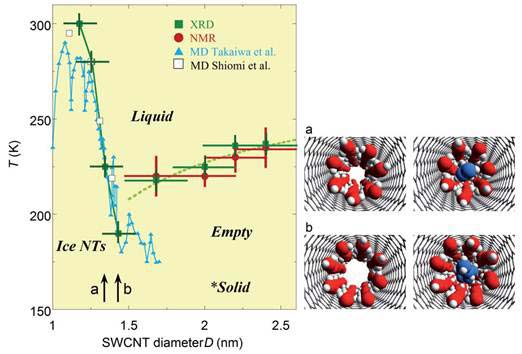
Figure 2 Temperature-diameter phase diagram of water inside SWNT left; XRD, X-ray diffraction data, NMR, nuclear magnetic resonance data; MD, molecular dynamics simulation; dotted line represents melting point of water in a capillary tube; * indicates solid phase obtained when rapidly quenched from high temperature; arrows a and b mark the diameters to either side of 1.4 nm where structures of water are presented (right) based on calculations, as hollow tubes when water content is low, and filled tubes when water content is high
As can be seen, at diameters > ~1.6 nm, the phase transition curve is rather similar to that of water in an ordinary capillary tube, increasing with diameter. (This water is still quite distinct from bulk water which freezes at 273 K; instead, it remains liquid at that temperature within all the confined spaces between 1.6 to 2.5 nm.) However, at diameters < ~1.4 nm, the phase transition curve goes dramatically in the opposite direction. The transition temperature rises sharply from ~170 K to 300 K as diameter decreases from ~1.4 nm to 1.17 nm. At the smallest diameter, the water remains frozen at room temperature.
Thus, water is almost infinitely flexible, which is why it forms a kaleidoscopic array of crystalline and quasicrystalline structures within the SWNTs, as in even ordinary snowflakes, each of which is unique. (A quasicrystal is an ordered structure that is not periodic, it lacks translational symmetry, which means that an arbitrary part of it cannot be shifted from its original position to another without destroying the symmetry. While crystals, according to the classical ‘crystallographic restriction theorem’, can possess only two, three, four, and six-fold symmetries, quasicrystals shows other symmetry orders, for instance five-fold, which is ‘forbidden’.)
Most fascinatingly, new evidence suggests that water confined in nanospace less than ~2.0 nm in diameter take on coherent quantum states that differ in energy according to the precise diameter of the nanospace, and the coherent quantum states are all very different from that of water in the bulk phase [2]. The hydrogen-bonding proton between the oxygen atoms of two neighbouring water molecules, O-H···O is effectively delocalized between the oxygen atoms, so you can no longer distinguish between the covalent O-H bond on the left and the H···O hydrogen bond on the right. That is why the confined water also super-conducts protons, which is extremely important for intercommunication within the cell and the organism. The movement of protons (and electrons) is the basis of the reduction/oxidation, or redox reactions that supply energy for all living activities (see later).
Water’s ability to form a variety of crystalline and quasicrystalline structures is most probably the reason it can help colloid crystals and quasicrystals self-assemble for numerous applications in nanoscale photonics and electronics. Colloids are nanoparticles of dimensions ranging from nanometres up to several mm suspended in water or other solvents. And colloid crystals are literally crystals made of colloid particles arranged in orderly fashion, like atoms in ordinary crystals.
In 2011, an international team led by Stephan Förster at the University of Bayreuth reported colloid quasicrystals that form spontaneously through self-assembly in water that had 12-fold and 18-fold symmetries (see Figure 3). Quasicrystals with 18-fold symmetry have never been reported up to then.
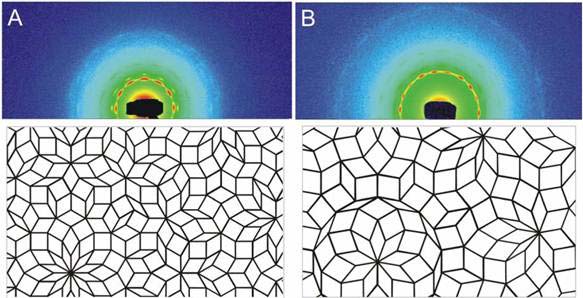
Figure 3 Colloid quasicrystlas self-assembled with 12-fold (left) and 18-fold (right) symmetries
Self-assembly facilitated by water is the key to how cells (and organisms) are exquisitely structured down to the molecular level such that entire enzyme pathways are in dynamic associations, or ‘metabolons’. A metabolon channels the metabolic product of one enzyme directly as substrate to the next enzyme in the metabolic pathway, thereby speeding up reactions at least a thousand fold compared to typical enzyme reactions in free solution. That is due to the extremely high local concentrations of both enzyme and substrate confined in a nano-volume, orchestrated and coordinated by a coherent nanodrop or of water. The Kreb’s cycle (tricarboxylic acid cycle, citric acid cycle) is an example of a metabolon.
Indeed, enzymes in reverse micelles (Figure 4) that mimic the nano-compartments in cells often exhibit ‘superactivity’ as well as greatly improved thermostability. (A reverse micelle has hydrophilic ends of molecules facing into the nanospace enclosed.)
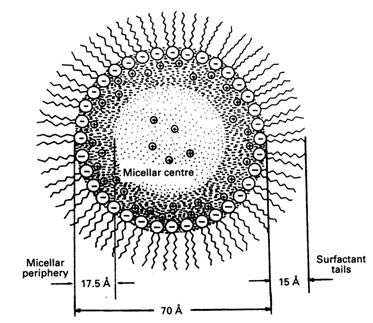
Figure 4 A reverse micelle
But how do enzymes and their substrates, and enzymes interacting with common substrates and products in an entire metabolic pathway manage to find one another in a cell crowded with all kinds of other molecules?
There is evidence that molecules that interact emit common electromagnetic frequencies, and are attracted by these same frequencies. So it is possible for the interacting molecules to be attracted to the surfaces of coherent water domains that are oscillating at, and emitting electromagnetic signals absorbed from their surroundings. At the surfaces of the coherent water domains the molecules are also provided with activation energy from the collective excitations of the coherent domains to carry out the appropriate reactions. That’s the theory, and it can be tested out by experiments on reverse micelles.
The same absorption of electromagnetic signals by coherent water domains may well underlie homeopathy. This is important in view of the claim that a DNA sequence of more than 100 base pairs can be reconstructed from specific signals - emitted by highly diluted samples of water previously in contact with the DNA – which were transferred to water that had never been in contact with the DNA.
Water’s prodigious flexibility makes it the perfect medium for the ‘quantum jazz’ that enables each molecular to intercommunicate ultimately with every other in a light, music and dance extravaganza that spans 20 orders of magnitude in space-time [1]. Water enables all performers to express their full degrees of freedom, to do their best, while providing at all times, the ultra-sensitive intercommunication channels that may trigger an abrupt change of phase at the global level.
Water is the supreme catalyst, the super-facilitator of chemical reactions, in the form of liquid crystalline coherent water that offers activation energy and specific attraction between enzyme and substrate; and also as the result of dynamic switching between the two states of water as envisioned by Phlippa Wiggins (which you can read about). In that way, water is not only the medium, but also both message and messenger of life.
Water provides the very means of life as the substrate for reduction/oxidation reactions, the fuel and dynamo that turns inanimate material into the living biosphere.
Reduction/oxidation, the basis of energy metabolism in living organisms, is electrons (and protons) moving between molecules and across membranes up and down the electrochemical gradient, it is the electric current that creates and animates life. The electrons and protons come ultimately from splitting water with energy trapped from sunlight in the process of photosynthesis.
H2O → 2H+ + 2e- + O (1)
That is possible only because coherent liquid crystalline water on interfaces is already excited, and to nearly ionisation level (ready to be split) according to del Giudice and colleagues, the coherent domains are effectively swarming with a plasma of almost free electrons. In the process of splitting water, electrons come loose with associated protons, which go to reduce carbon dioxide into carbohydrates, and most importantly, oxygen is released to support multicellular aerobic organisms that breathe in oxygen to oxidize the foodstuffs in respiration.
The invention of photosynthesis by cyanobacteria and later, the algae and green plants has greatly increased the electrochemical range available to the biosphere, enabling it to expand enormously up to and including the human species.
Photosynthesis and respiration is the truly the dynamo of life, the magic roundabout that transforms inanimate molecules into living beings (Figure 5).
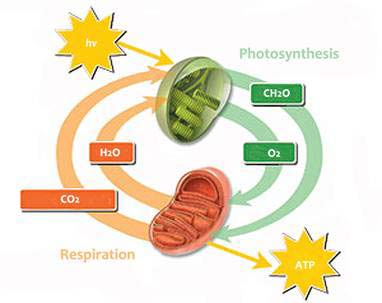
Figure 5 The dynamo of life running on water
How does the movement of electrons actually animate the cell and organisms? One intriguing answer is offered by Gilbert Ling more than 50 years ago in his association-induction hypothesis. It proposes that that the major components of living protoplasm – water, proteins, and K+ - exist in a closely associated, high-energy state at ‘rest’. Within the resting cell, most if not all proteins are fully extended (instead of being bound up in a-helix or b-pleated sheet secondary structure as usually portrayed) so that the peptide bonds along their polypeptide backbone are free to interact with water molecules to form ‘polarized oriented multilayers’ (POM) of water molecules (which I call liquid crystalline water), while the carboxylate side-chains preferentially bind K+ over Na+. Both are due to the ubiquitous presence of ATP in living cells. And that is perhaps why ATP is maintained at a constant concentration in living cells.
In the absence of ATP, proteins tend to adopt secondary structures – a-helix, or a b-pleated sheet - as hydrogen bonds form between peptide bonds in the same chain or between different chains, so they don’t interact with water. In this state, the carboxylate and amino side chains are also unavailable for binding ions, as they can pair up in a salt linkage (combination of basic and acidic groups) with each other. And the water next to the protein is in a more disordered state.
However, when ATP is bound to a certain ‘cardinal site’ of the protein, it withdraws electrons away from the protein chain, thereby inducing the hydrogen bonds to open up, unfolding the chain, exposing the peptide bonds on the backbone, and enabling them to interact with water to form POM. At the same time, the carboxylate and amino side chains open up to interact with the appropriate inorganic cation and anion respectively. The cation is K+ in preference to Na+, because ATP binding turns the carboxylate group into a strong acid that prefers K+ over Na+; which explains why the intracellular concentration of K+ is so much higher relative to Na+. When ATP is split into ADP and Pi, and detaches from the protein, the reverse change takes place, the protein reforms its secondary structure and expels the POM water.
Note the major change in the water between an ordered coherent liquid crystalline (POM) state and a relatively disordered state that accompanies a mechanical change in the protein from an extended to a folded-up conformation. Something like this could well be how actin and myosin function in muscle contraction, and how molecular-motors function in other cells.
Ling has referred to his model as an ‘elemental living machine’ that is generally applicable to how proteins work, by electronic induction. In conventional cell biology, ligands binding to receptors, phosphorylation of key proteins, transient Ca2+ pulse, etc., are so-many ‘signal transductions’ that cause a ‘conformation change’ in some key protein that leads to downstream effects. If Ling is right, they are all aspects of electronic induction – either electron withdrawing or electron donating - which changes the proteins and associated coherent water structure, resulting in a major state transition in the ‘nanoprotoplasm’ that substantially alters the chemical propensities of molecules.
Accompanying the flow of electrons are movement of protons in a ‘protoneural network’, as envisaged by Rickey Welch, now at Cambridge University UK, that delivers the appropriate chemistry as required, not only within the cell, but throughout the extracellular matrix of the entire organism.
I hope you can see by now that life based on water is quantum electrodynamic through and through. Water provides the substrate, the fuel and generator that animate life. It is the source of free electrons and protons that wire up organisms making and breaking complex molecules for organisms to develop and grow, to multiply and to do all that makes life passionate and exciting. At the same time, it provides the perfect medium for molecules to perform their best at all time and to intercommunicate with one another. Living water thereby acts as perfect messenger between molecules and delivers the message of the global coherent whole in the quantum jazz extravaganza of life.
Article first published 18/07/12
Comments are now closed for this article
There are 2 comments on this article.
Amanda Blay Comment left 19th July 2012 06:06:37
The mention of the quantum electrodynamic and the reference to the absorption of electromagnetic signals - could this assist in an understanding of electro- hypersensitivity recognised by some individuals - perhaps we should re-examine the effect of ambient electromagnetic fields in our environment and how they influence the health of plant and mammals.
Plus recognise the combined effect of all the different frequencies to which we are routinely exposed 24 hours a day
Mae-Wan Ho Comment left 19th July 2012 17:05:21
Yes indeed, ISIS has many articles on the issue of organisms' sensitivity to ultraweak electromagnetic fields such as high tension power lines and mobile phones dating back 10 years. This issue is dealt with in some detail also in Living Rainbow H2O.
We are all sensitive to ultraweak electromagnetic fields, some people exhibit more obvious symptoms and are recognized as electrosensitive. But even asymptomatic people are affected. The evidence linking frequent use of mobile (and cordless) phones to brain tumours (both benign and malignant) is substantial.